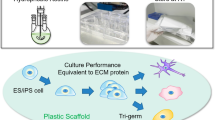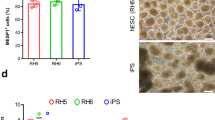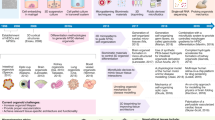Abstract
Human embryonic stem cells (hESCs) have two properties of interest for the development of cell therapies: self-renewal and the potential to differentiate into all major lineages of somatic cells in the human body. Widespread clinical application of hESC-derived cells will require culture methods that are low-cost, robust, scalable and use chemically defined raw materials. Here we describe synthetic peptide-acrylate surfaces (PAS) that support self-renewal of hESCs in chemically defined, xeno-free medium. H1 and H7 hESCs were successfully maintained on PAS for over ten passages. Cell morphology and phenotypic marker expression were similar for cells cultured on PAS or Matrigel. Cells on PAS retained normal karyotype and pluripotency and were able to differentiate to functional cardiomyocytes on PAS. Finally, PAS were scaled up to large culture-vessel formats. Synthetic, xeno-free, scalable surfaces that support the self-renewal and differentiation of hESCs will be useful for both research purposes and development of cell therapies.
This is a preview of subscription content, access via your institution
Access options
Subscribe to this journal
Receive 12 print issues and online access
$209.00 per year
only $17.42 per issue
Buy this article
- Purchase on Springer Link
- Instant access to full article PDF
Prices may be subject to local taxes which are calculated during checkout



Similar content being viewed by others
References
Thomson, J.A. et al. Embryonic stem cell lines derived from human blastocysts. Science 282, 1145–1147 (1998).
Reubinoff, B.E., Pera, M.F., Fong, C.Y., Trounson, A. & Bongso, A. Embryonic stem cell lines from human blastocysts: somatic differentiation in vitro. Nat. Biotechnol. 18, 399–404 (2000).
Guhr, A., Kurtz, A., Friedgen, K. & Loser, P. Current state of human embryonic stem cell research: an overview of cell lines and their usage in experimental work. Stem Cells 24, 2187–2191 (2006).
Amit, M. et al. Human feeder layers for human embryonic stem cells. Biol. Reprod. 68, 2150–2156 (2003).
Richards, M. et al. Comparative evaluation of various human feeders for prolonged undifferentiated growth of human embryonic stem cells. Stem Cells 21, 546–556 (2003).
Xu, C. et al. Feeder-free growth of undifferentiated human embryonic stem cells. Nat. Biotechnol. 19, 971–974 (2001).
Stojkovic, P. et al. Human-serum matrix supports undifferentiated growth of human embryonic stem cells. Stem Cells 23, 895–902 (2005).
Lu, J., Hou, R., Booth, C.J., Yang, S.H. & Snyder, M. Defined culture conditions of human embryonic stem cells. Proc. Natl. Acad. Sci. USA 103, 5688–5693 (2006).
Li, Y., Powell, S., Brunette, E., Lebkowski, J. & Mandalam, R. Expansion of human embryonic stem cells in defined serum-free medium devoid of animal-derived products. Biotechnol. Bioeng. 91, 688–698 (2005).
Ludwig, T.E. et al. Derivation of human embryonic stem cells in defined conditions. Nat. Biotechnol. 24, 185–187 (2006).
Oldberg, A., Franzen, A. & Heinegard, D. The primary structure of a cell-binding bone sialoprotein. J. Biol. Chem. 263, 19430–19432 (1988).
Suzuki, S., Oldberg, A., Hayman, E.G., Pierschbacher, M.D. & Ruoslahti, E. Complete amino acid sequence of human vitronectin deduced from cDNA similarity of cell attachment sites in vitronectin and fibronectin. EMBO J. 4, 2519–2524 (1985).
Pierschbacher, M.D. & Ruoslahti, E. Cell attachment activity of fibronectin can be duplicated by small synthetic fragments of the molecule. Nature 309, 30–33 (1984).
Nomizu, M. et al. Cell binding sequences in mouse laminin α1 chain. J. Biol. Chem. 273, 32491–32499 (1998).
O'Connor, M.D. et al. Alkaline phosphatase-positive colony formation is a sensitive, specific, and quantitative indicator of undifferentiated human embryonic stem cells. Stem Cells 26, 1109–1116 (2008).
Li, Y.J., Chung, E.H., Rodriguez, R.T., Meri, T.F. & Healy, K.E. Hydrogels as artificial matrices for human embryonic stem cell self-renewal. J. Biomed. Mater. Res. A 79, 1–5 (2006).
Hern, D.L. & Hubbell, J.A. Incorporation of adhesion peptides into nonadhesive hydrogels useful for tissue resurfacing. J. Biomed. Mater. Res. 39, 266–276 (1998).
Allegrucci, C. & Young, L.E. Differences between human embryonic stem cell lines. Hum. Reprod. Update 13, 103–120 (2007).
Pekkanen-Mattila, M. et al. Substantial variation in the cardiac differentiation of human embryonic stem cell lines derived and propagated under the same conditions-a comparison of multiple cell lines. Ann. Med. 22, 1–15 (2009).
Laflamme, M.A. et al. Cardiomyocytes derived from human embryonic stem cells in pro-survival factors enhance function of infarcted rat hearts. Nat. Biotechnol. 25, 1015–1024 (2007).
Derda, R. et al. Defined substrates for human embryonic stem cell growth identified from surface arrays. ACS Chem. Biol. 2, 347–355 (2007).
Braam, S.R. et al. Recombinant vitronectin is a functionally defined substrate that supports human embryonic stem cell self-renewal via alphavbeta5 integrin. Stem Cells 26, 2257–2265 (2008).
Acknowledgements
We would like to thank our sponsors from Corning Incorporated, J. Mooney and M. McFarland, and from Geron Corporation, J. Lebkowski and A.H. Davies. From Corning Incorporated we thank A. Frutos for critical reading and helpful comments on the manuscript, M. Lewis for his chemistry expertise, T. Garvey for his assistance in PAS fabrication, P. Gagnon and P. Szlosek for substrate plate supply and T. Heck for his confocal imaging help. From Geron Corporation we thank K. Delavan-Boorsma and S. Edell for their support of in vivo studies.
Author information
Authors and Affiliations
Contributions
Z.M. conceived, designed, performed and analyzed PAS validation with H7 cells. J.L.W. conceived, designed, performed and analyzed PAS validation with H1 cells, wrote supplementary materials. P.D.-S. and J.Y. designed, performed and analyzed cardiomyocyte differentiation on PAS. J.Y. designed, performed and analyzed EB differentiation. L.Q. assisted J.Y. in performing and analyzing cardiomyocytes and EB differentiation. C.A.P. performed teratoma formation studies. D.M.W., A.G.F. and Y.Z. conceived, designed, developed and fabricated PAS. D.M.W. identified peptides for the study, characterized surface peptide uniformity, contributed to design of peptide conjugation scheme. A.G.F. developed and optimized peptide conjugation and characterized surface peptide density. C.S. assisted Y.Z. in acrylate coating development and fabrication. A.M., J.N. and P.W. developed coating conditions for PAS in T75 format, fabricated PAS-T75. Z.M. and R.B. wrote the manuscript. J.P.B., S.P. and R.B. provided direction and guidance for the various areas of the project.
Corresponding authors
Ethics declarations
Competing interests
Z.M., J.L.W., P.D.-S., J.P.B., S.P., D.M.W., A.G.F., Y.Z., C.S., A.M., J.N. and P.W. are employees of Corning Incorporated. J.Y., L.Q., C.A.P. and R.B. are employees of Geron Corporation.
Supplementary information
Supplementary Text and Figures
Supplementary Tables 1,2 and Supplementary Figs. 1–6 (PDF 1273 kb)
Rights and permissions
About this article
Cite this article
Melkoumian, Z., Weber, J., Weber, D. et al. Synthetic peptide-acrylate surfaces for long-term self-renewal and cardiomyocyte differentiation of human embryonic stem cells. Nat Biotechnol 28, 606–610 (2010). https://doi.org/10.1038/nbt.1629
Received:
Accepted:
Published:
Issue Date:
DOI: https://doi.org/10.1038/nbt.1629
This article is cited by
-
Methanol fixed feeder layers altered the pluripotency and metabolism of bovine pluripotent stem cells
Scientific Reports (2022)
-
A chemically-defined plastic scaffold for the xeno-free production of human pluripotent stem cells
Scientific Reports (2022)
-
Synthetic alternatives to Matrigel
Nature Reviews Materials (2020)
-
Characterization of dystroglycan binding in adhesion of human induced pluripotent stem cells to laminin-511 E8 fragment
Scientific Reports (2019)
-
Long-Term Maintenance of Human Pluripotent Stem Cells on cRGDfK-Presenting Synthetic Surfaces
Scientific Reports (2018)



